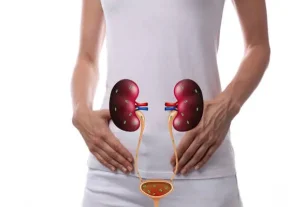Bloody discharge can occur at the beginning or end of menstruation, during climacteric or menopause, after sexual intercourse, or be caused by infection, polyps, contraceptive use, endometriosis or uterine cancer.
Depending on the cause, bloody discharge may be accompanied by other symptoms, such as pain and burning when urinating, weight loss, abdominal swelling, intense cramps and excessive menstruation.
Therefore, if the bloody discharge is persistent and accompanied by other symptoms, it is recommended to consult a gynecologist so that an evaluation can be carried out, the cause identified and the most appropriate treatment initiated.

The main causes of bloody discharge are:
1. Beginning or end of menstruation
At the beginning or end of menstruation, it is common to notice the presence of a small amount of blood in the vaginal discharge. At the beginning, due to the low amount of blood, it is common for the discharge to be pinker, while at the end of menstruation, the discharge is darker due to blood oxidation.
What to do: In this case, it is not necessary to carry out any type of treatment, as it is a normal situation, happening regularly every month. Understand how the menstrual cycle works.
Don’t ignore the signs your body is giving you!
2. Sexual intercourse
In some cases, after sexual intercourse there may be a slight bloody discharge due to irritation of the vagina and small wounds that may form in the vaginal canal.
What to do: In general, it is not necessary for a gynecologist to be consulted. However, if bloody discharge persists a few days after intercourse, is very intense or is accompanied by other symptoms, it is important that a doctor be consulted so that an assessment can be made of the genital area and the best treatment can be recommended, if necessary. .
3. Polyps
The presence of endometrial polyps can also cause bloody discharge, and is usually accompanied by other symptoms, such as abdominal pain and difficulty getting pregnant. See more about endometrial polyps.
What to do: It is important that the gynecologist is consulted so that the presence of the polyp can be investigated and treatment can be started, which may involve surgery to remove the polyp, especially when it is large. However, in cases where the endometrial polyp is small, regular follow-up with the doctor may only be recommended.
4. Climacteric or menopause
Menopause and menopause are situations in which there is a hormonal imbalance, so there may be small discharges with blood during this period, in addition to other symptoms such as hot flashes, mood changes, changes in libido and tiredness.
The climacteric is a woman’s transition period, in which she passes from the reproductive to the non-reproductive phase, starting between the ages of 40 and 45, lasting around 3 years and irregular menstrual cycles may occur. Menopause is when there is an absence of menstruation. Find out more about menopause.
What to do: It is recommended to consult a gynecologist to have hormonal levels assessed and, thus, begin hormone replacement treatment to help control and alleviate symptoms, promoting the woman’s quality of life.
5. Use of contraceptives
The use of contraceptive pills can also lead to bloody discharge, especially at the beginning of use, as the body is still adapting to hormonal levels. In addition, there may also be bloody discharge when changing contraceptives and when taking a break from contraceptive use, which is considered normal.
What to do: The gynecologist should recommend the best contraceptive and provide guidance on its use, as well as its effects. If bloody discharge is frequent and/or accompanied by other symptoms, such as cramps and abdominal discomfort, for example, it is important to inform the doctor so that the possibility of changing the contraceptive can be assessed. See more details on how contraceptives work.
6. Infection
Some sexually transmitted infections (STIs), mainly chlamydia, may have bloody discharge as a symptom, which can occur after sexual intercourse or between menstrual cycles. In addition to bloody discharge, other symptoms may be noticed, such as pain and burning when urinating and pelvic pain. Learn about other symptoms of chlamydia.
What to do: In this case, it is recommended to undergo treatment as advised by your doctor, who may recommend the use of antibiotics to eliminate the bacteria. It is important that the treatment is carried out until the end and should not be interrupted when the symptoms have disappeared, as the bacteria may not have yet been eliminated.
7. Endometriosis
Endometriosis is a condition in which endometrial cells grow outside the uterus, causing symptoms such as intense cramping, pain during sexual intercourse, abdominal swelling, constipation or diarrhea, heavy menstruation and, in some cases, bloody discharge. Know how to recognize the symptoms of endometriosis.
What to do: It is important to follow the treatment advised by your gynecologist to alleviate symptoms and prevent the disease from progressing. Therefore, the use of anti-inflammatory and hormonal medications may be recommended, in addition to surgery, in more advanced cases. Check out more details about the treatment for endometriosis.
8. Uterine cancer
Uterine cancer, also called cervical cancer, can also have bloody discharge as a symptom, especially in the more advanced stages of the disease, which can occur after sexual intercourse, in some cases. In addition, it also causes abdominal pain, a feeling of pressure in the lower part of the belly and weight loss for no apparent reason.
What to do: Treatment for uterine cancer must be guided by the gynecologist according to the cause of the cancer, symptoms presented and stage of the disease, and conization of the uterus, hysterectomy, radiotherapy and chemotherapy may be indicated. Find out how uterine cancer is treated.

Sign up for our newsletter and stay up to date with exclusive news
that can transform your routine!
Warning: Undefined array key "title" in /home/storelat/public_html/wp-content/plugins/link-whisper-premium/templates/frontend/related-posts.php on line 12
Warning: Undefined array key "title_tag" in /home/storelat/public_html/wp-content/plugins/link-whisper-premium/templates/frontend/related-posts.php on line 13



